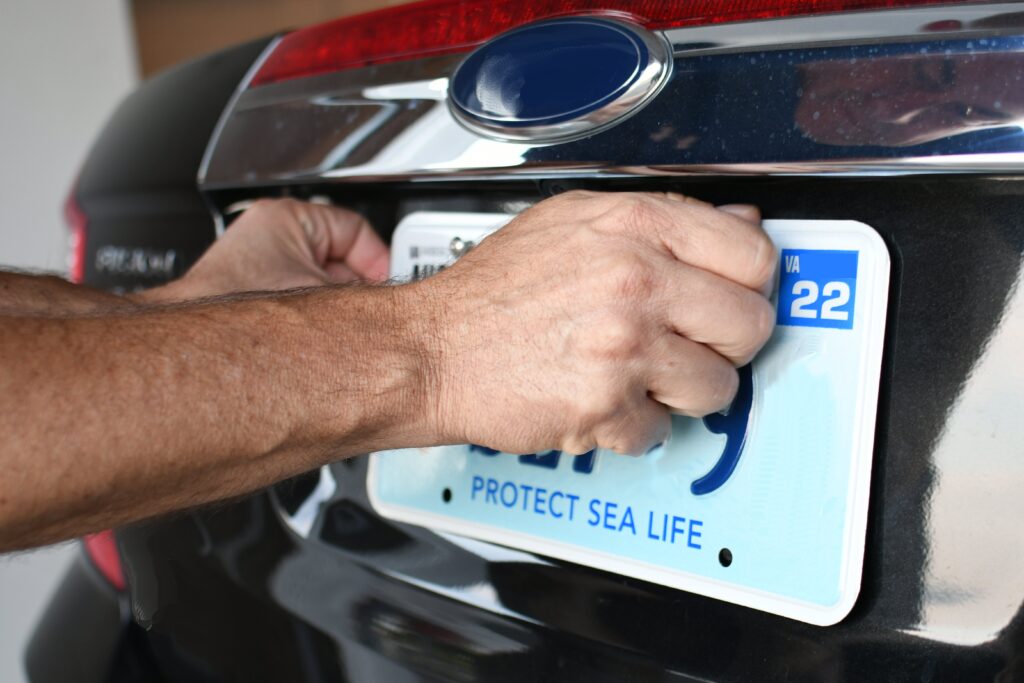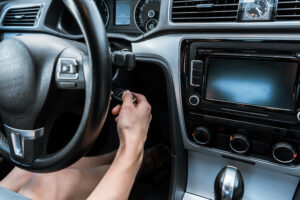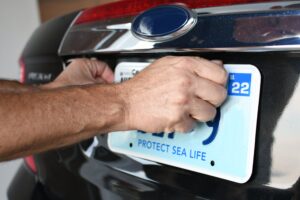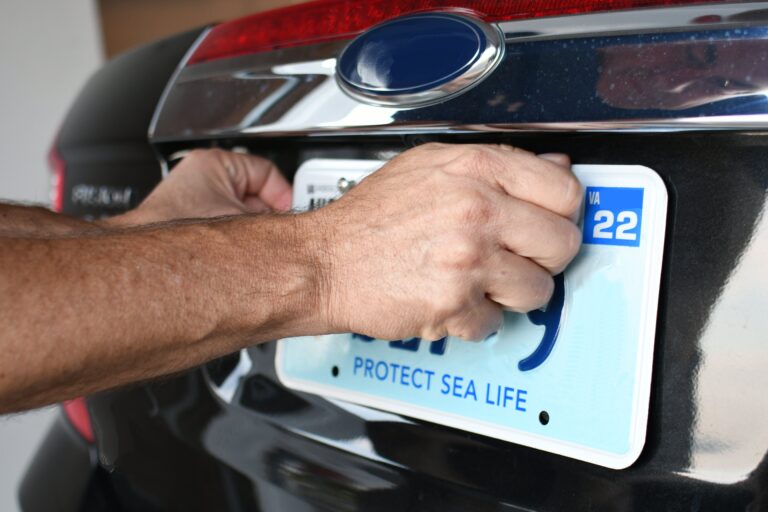Staring at the naked rear bumper of your new used car, you realize there’s no pre-drilled holes for mounting the license plate. Do you dig out your old power drill and hope for the best? Or fork over hard-earned cash to have a professional handle this seemingly simple task?
Like many owners of older vehicles, you may find yourself asking the question “How Much is it to Ask Mechanic to Drill a License Plate for Us?” and are in need of having license plate mounting holes drilled. But before revving up a drill yourself, it’s important to understand what’s involved – from regulations and costs to proper techniques. Rushing into a DIY drilling job risks scratches, misaligned holes, and violations.
When You Would Need to Get Holes Drilled
First, determine if you even need to get holes drilled in the first place. Many modern cars come with standardized mounting holes already drilled for license plates from the factory. However, there are several situations where you may need to visit a mechanic aftermarket to have holes drilled:
- Older used cars often lack proper license plate mounting holes
- Vanity license plates may require different locations than factory holes
- If your state requires front and back plates, you’d need the front bumper drilled
- To reposition the plate or use different sized/style than factory holes
The first step is inspecting your particular car’s bumpers to see if mounting holes have already been pre-drilled. This is common on most modern domestic and import cars, but not universal. Bend down and look up under the rear bumper, feeling with your fingers for existing holes. Also check the front bumper if your state requires both rear and front license plates mounted.
If no holes exist, double check with your local DMV for the exact regulations in your state regarding license plate mounting. Most states require at least two holes drilled in the rear bracket area to attach the plate. If front plates are mandatory, then four total holes are needed typically. The information on proper hole locations and measurements should be available in your vehicle owner’s manual as well.
Once you’ve determined that drilling is necessary, it’s prudent to have a professional mechanic complete the work rather than attempting it yourself without experience. The stakes are low cost-wise, but a botched DIY drilling job could lead to expensive body repairs.
Factors That Influence the Cost of Drilling Holes

When asking for quotes from mechanics on drilling your license plate holes, what determines the total price? Here are some of the main factors:
Number of holes needed
The more holes that have to be drilled, the more work and higher cost. Two holes is standard for rear license plates in most states. But if a front plate is also required, then four holes total are needed – two in front and two rear. Make sure you understand your state’s exact regulations.
Shop hourly rates
Like most automotive work, the baseline cost will be the shop’s hourly labor rate. Expect anywhere from $70 per hour for independent mechanics up to $150 per hour at high-end dealerships. It’s a quick job, so the total fees will just be a fraction of an hourly rate.
Materials and parts
For basic drilling, there’s minimal material costs – usually just proper drill bits. However, many mechanics will also insert plastic grommets or rubber isolators into the holes for a more finished look. These small parts run just a few dollars. Fancier specialty license plate mounting hardware is available, but not really necessary for most vehicles.
Location and convenience fees
Shops located in main city centers and high-rent districts will often charge higher hourly rates for labor compared to independent mechanics in suburbs or small towns. Mobile mechanics who come to your home or office usually command premium rates for that convenience.
Vehicle make and model
More work will generally be required to drill holes on vehicles without existing US-spec license plate mounting locations. Some European and Asian imports have no standard bracket holes from the factory. Plus exotics, vintage cars, and salvage title vehicles often require more custom work as well.
Getting Quotes From Local Mechanics
Once you know exactly what needs to be done on your car, it’s time to get some price quotes. There are a few different ways to research rates and find the best deal:
Call around to multiple shops
Get on the horn and call around to various local auto shops, dealership service departments, body shops, and independent mechanics. Explain the year/make/model of your vehicle and exactly what holes need to be drilled. Ask what their shop rate is and how much they’d charge for labor to install your license plate holes.
Use online quote request forms
Many repair shops now have online forms where you can enter information about your car and requested repairs to get free quotes emailed back. This allows you to easily contact several places for estimates without having to call each one. It also provides written documentation of the quotes you received.
Check online reviews
In addition to quoted prices, look for online customer reviews on shops you’re considering. While mechanics can drill holes reasonably cheaply, attention to detail and workmanship can vary. See what others report about their overall service experience.
In general, you can expect quotes in the following ranges:
- $10-$30 to drill just two standard holes
- $30-$60 for four total holes (front and back plates)
- $100+ for installing holes on high-end luxury or exotic cars
However, the only way to know for sure is getting firm quotes directly from the shops in your area that you’re considering to perform the work.
Factors That Can Increase the Costs
There are a few situations that can significantly increase the amount of work required and thus the total costs to drill license plate holes:
Import vehicles with non-standard bumpers
On European and Asian import cars that were never meant to have a US license plate originally, often there is no good existing location to mount the plate. This requires more custom work, potentially using special brackets and parts to find a suitable way to mount the plate.
Plastic bumper covers vs metal bumpers
Modern cars often have plastic bumper covers which are easier to drill into cleanly than old school solid steel bumpers. Metal requires more heavy duty tools and skills for drilling without damaging the surrounding area.
Widening existing holes
If your car has existing holes that are too small or misaligned, it takes extra time and work to widen them compared to drilling fresh holes in the optimum location. Widened holes may also turn out less aesthetically pleasing.
Modifying front bumpers and grilles
Getting to the front bumper on many modern cars can be more complex and time consuming if extensive disassembly is required to access the area behind grilles and below the hood.
Questions to Ask Your Mechanic
When getting quotes for drilling your license plate holes, here are some good questions to ask the mechanic or shop:
Where exactly will you drill the holes?
There are standardized measurements, but the precise ideal positioning differs for each vehicle make and model. Ask them to explain their plan for hole placement on your specific car.
What tools will you use?
A basic power hand drill is usually adequate, but metal bumpers may require a heavier duty drill. Make sure they plan to use sharp drill bits and lubrication for smooth hole cutting.
How will you prevent damaging the body?
Look for attention to detail – like using protective sheeting underneath during drilling to prevent metal shavings from scratching the paint. No loose wires or mechanical parts should be impacted either.
How long will it take?
A regular two hole rear plate install should take 10-15 minutes at most for an experienced mechanic. If they quote over an hour for basic drilling, the labor fees may be excessively high.
Will you deburr the holes?
Proper finishing is important so ask if the mechanic will deburr or smooth any sharp edges around the holes. Rubber grommets can provide a clean finish.
DIY Tips for Drilling Your Own Holes
If you want to tackle drilling the holes yourself as a DIY project, here are some tips:
- Use a template matched to your license plate for perfect spacing of holes
- Work slowly and carefully, starting with a small pilot hole before increasing size
- Keep the drill bit perpendicular to the surface and let it do the work
- Apply touch up paint to prevent rust on edges
- Deburr holes carefully with a file or sandpaper after drilling
- Double check measurements and test fit plate before final install
However, even with proper preparation, DIY drilling has a higher margin of error. Making mistakes could lead to the need for expensive bodywork repairs if you damage the bumper or surrounding paint. Leaving ragged holes with sharp edges can lead to unsightly rusting down the road as well.
Benefits of Professional Installation
Having a trained mechanic handle drilling your license plate holes provides important benefits:
Proper positioning – They have suitable tools and experience to identify the optimal industry standard placement for holes on your particular vehicle.
Durable holes – Mechanic’s heavy duty power tools leave cleanly cut, precision holes that won’t become enlarged or ragged over time.
Protects value – No need to worry about mistakes leading to body damage that hurts resale value.
Convenience – Quick 10-15 minute job completed during other scheduled maintenance.
Why Ask Auto Mechanics is the Best Ask a Mechanic Service

When you need answers from knowledgeable mechanics without the high hourly shop rates, Ask Auto Mechanics is the top choice. Here’s why:
- Real experts – Get direct advice from ASE certified mechanics with decades of real-world experience.
- Fast answers – Mechanics respond quickly, often within minutes for common questions.
- Low cost – Pay per question, not hourly shop rates. Helpful for DIYers.
- Convenience – Ask from your phone or computer anytime, anywhere. No need for appointments.
- Reliable info – Advice comes from professionals, not forums. Gives DIY confidence.
- Range of topics – Get help with makes/models, repairs, parts, estimates and more.
With high quality expertise on demand 24/7 and for a low price, our ask a mechanic service is the go-to for auto mechanics advice without the shop visit.
When to Ask a Mechanic Instead of DIY
Some common situations when it pays to get professional mechanic advice:
- If tackling any major repair for the first time
- Diagnosing an engine light, leak, noise or other problem
- Needing help deciding between complex repair options
- For accurate cost estimates before work is done
- Any task requiring special tools you don’t own
- Unsafe for DIY like airbag resets or hybrid systems
- Working under precarious jacking points like lifted trucks
- Installs that impact resale value if done incorrectly
In addition to the expertise itself, pro tips can also save you money by avoiding mistakes that lead to bigger issues down the road. Paying a few bucks for answers gives DIY confidence and prevents the much higher costs of repairs if something goes wrong. We recommend asking our online mechanic.
Final Takeaways
- Research regulations to determine exactly how many holes you need for compliance
- Shop around for quotes from various reputable mechanics
- Simple two hole rear plate drilling typically just $10-$30
- Extra holes or complications can significantly increase costs
- Leaving it to experienced professionals minimizes risks of DIY errors
Drilling holes for your license plate is usually one of the simplest and most affordable services you’ll need from a mechanic. But properly displayed tags are crucial for avoiding violations and penalties. By understanding what’s involved and average costs, you can feel confident choosing a shop to perform this quick and straightforward task.
Frequently Asked Questions How Much is it to Ask Mechanic to Drill a License Plate for Us
What size hole for license plates?
The standard size is 1/4 inch. This allows screw clearance while minimizing empty space if moved later. Ask Auto Mechanics for specifics on your vehicle.
How to install license plate mount?
Mark hole locations properly, drill 1/4 inch holes straight, add grommets, attach plate with screws. Ask mechanics at Ask Auto Mechanics for detailed steps.
What tools needed to install license plates?
Electric drill and 1/4 inch metal bit are essential. Lubricant and grommets also helpful. Ask Auto Mechanics has tips on proper tools.
How to drill front license plate holes?
Use right angle drill if tight space behind grille. Take precautions - eye protection, remove covers. Ask Auto Mechanics for specific front plate drilling pointers.
Can you drill into 4D acrylic plates?
Yes, with care. Use step-drill bit and lubricant. Drill slowly to prevent cracking. Ask classic car mechanics at Ask Auto Mechanics about best practices for vintage plates.












